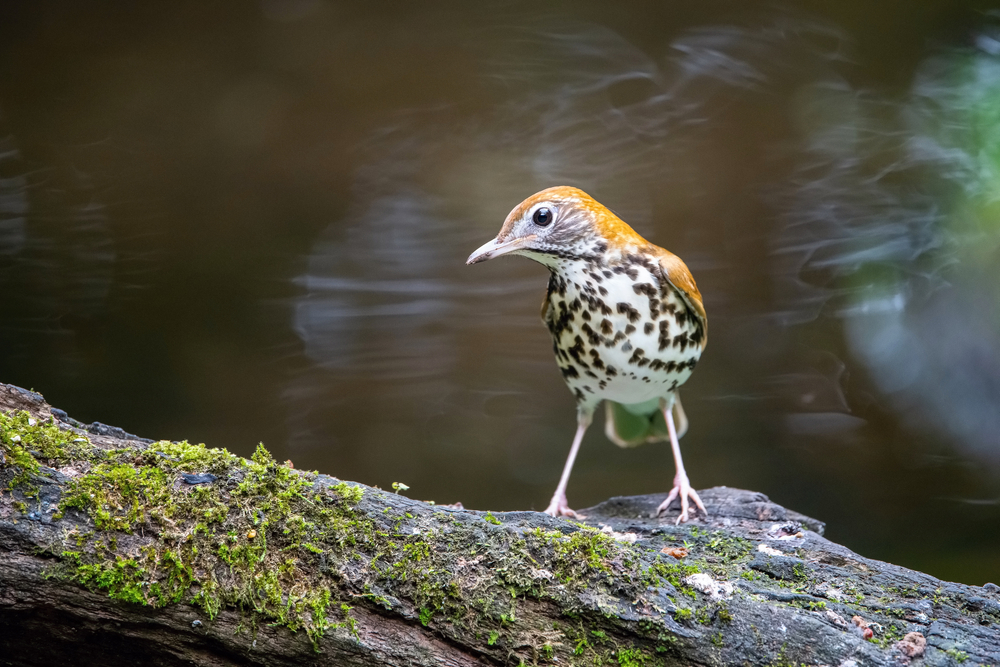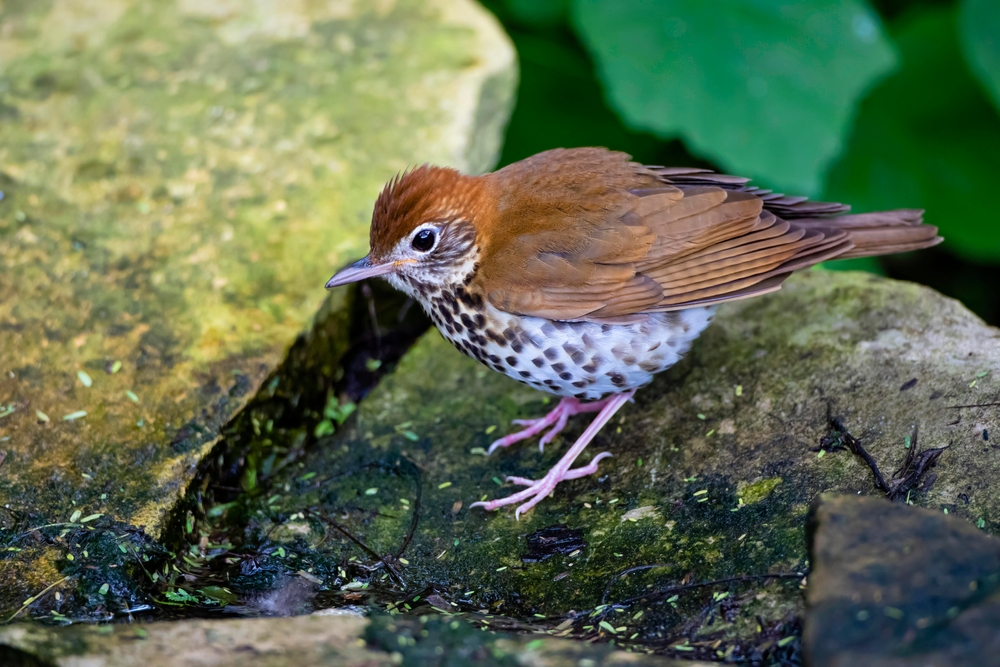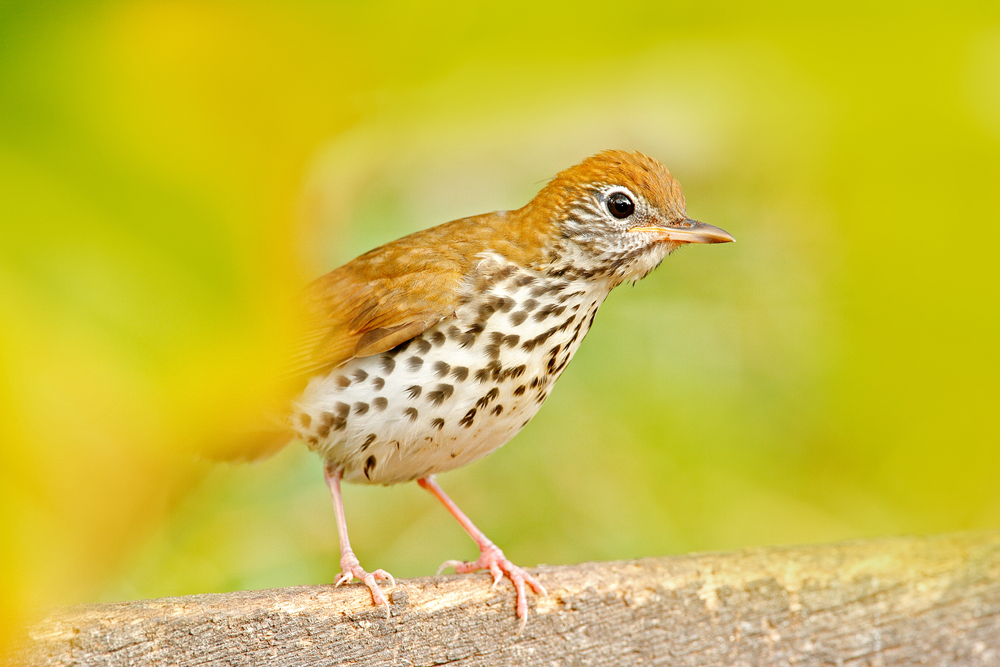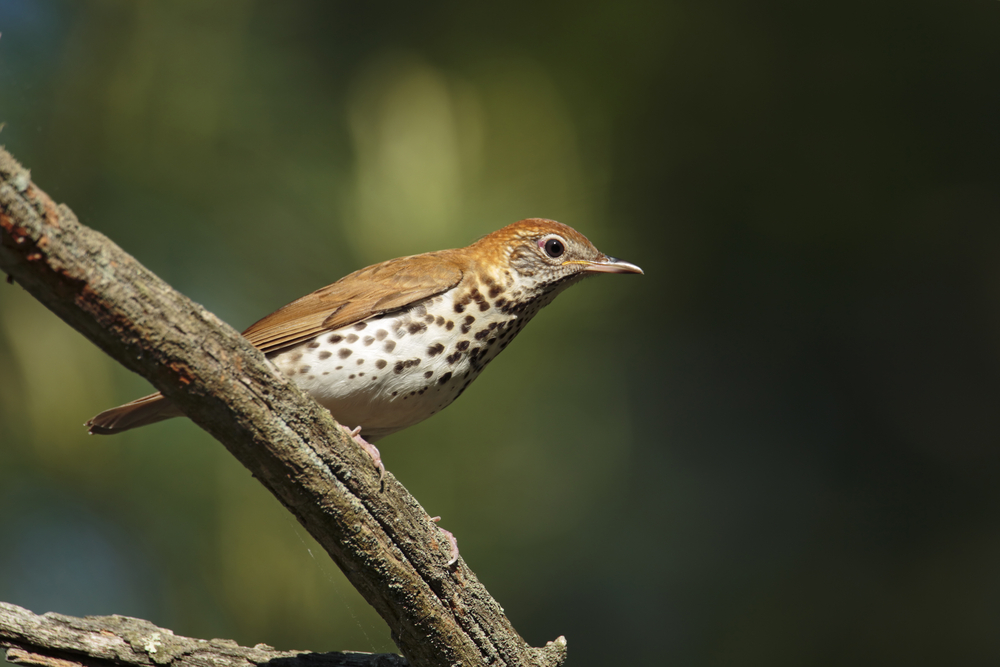The Wood Thrust is a North American migratory songbird that lives primarily in the eastern U.S and parts of Canada. Like the American Robin, it’s a member of the Turdidae family. If you want to glimpse the elusive Wood Thrush, look in thick and lush deciduous forests.
While it shares very much in common with the American Robin, Veery, and its cousin, the Hermit Thrush, its unique plumage and upbeat summer songs make it stand apart. Wood Thrushes are known for their cheery songs and striking polka-dotted plumage. Their populations are on the decline, but you can still catch a glimpse of these showy songbirds if you head into thick deciduous forests in the eastern U.S.
Wood Thrush Songbird Identification
The Wood Thrush (Hylocichla mustelina) is primarily brown and white, similar to the American Robin. Think of the Wood Thrush like an America Robin with a fancier outfit. It’s slightly smaller than a Robin but larger than its cousin, the Hermit Thrush. The most notable feature of this North American songbird is the exaggerated black spots on its underparts.
It has a puffy pot belly accented with bold polka dots, making sightings easy for birdwatchers. It has a cinnamon brown color on its head, an unmistakable white eye ring, and black eyes. Like the American Robin, male and female Wood Thrushes look almost identical.

Habitat and Diet
Wood Thrushes are migratory birds and spend their breeding months in dense deciduous forests in North America. Their habitat spans the entirety of the eastern US, from states such as Florida, New York, and into parts of Canada. As their name suggests, Wood Thrushes prefer the dense cover of old forests. They tend to stick to forest areas with plenty of brushy undergrowth with a high understory and near a body of water.
These rich forest habitats provide the Wood Thrush with plenty of available food sources. In the breeding months, they live on a diet of protein-rich bugs such as caterpillars, snails, and other bugs found while scavenging through the leaf litter on the forest floor. After the breeding season, the Wood Thrush transitions to a diet comprised primarily of fruit and nuts.
Mating, Nesting, and Eggs
Male Wood Thrushes often arrive back in their breeding ground before the females start mid-May. Their breeding season kicks off in early May and usually lasts as late as mid-September, although some may leave sooner. Wood Thrushes are monogamous songbirds and pair with one mate throughout the breeding season.
Male Wood Thrushes sing from dusk until dawn to attract a mate and establish their nesting territory. Their songs are loudest and more prevalent early in the mating season and become abbreviated as the breeding season winds down.
The female Wood Thrush not only selects the nesting location but also builds the nest. Their nesting sites sit high off the ground in the treetops on the branch of a deciduous tree. The female builds the nest of materials such as weeds, twigs, leaves, and dead grass and lines it with mud.
Once the female completes her nest construction, she lays one egg per day and an average of three eggs per clutch. On average, a pair of mated Wood Thrushes raise two broods per season, although there have been some instances when they raise three.

Geography and Range of Migration
The mating season of the Wood Thrush starts in mid-May and lasts through mid-September. During the breeding months, Wood Thrushes reside in most parts of the eastern U.S and parts of Canada.
When the breeding season is over, these long-distance migrants pack up and head south to Mexico and Central America. While they don’t spend much time in the Midwest or parts of the south in the United States, residents of Texas may be able to catch a glimpse of these songbirds as they migrate south to their wintering grounds.
Vocal Repertoire: Songs, Calls, and Sounds
The Wood Thrush song gives the America Robin a run for its money song department. It has a lovely flute-like song with a few more ee-oh-lay accents, trills, and flourishes than the America Robin. The Wood Thrush is a part of the dawn chorus and starts singing well before the sun comes up.
During the breeding season, this avid singer is one of the most notable songbirds in the eastern US and often sings up until dusk. Their songs are loud at the start of the breeding season and carry through the lush deciduous forests. Their songs soften as the breeding season winds down until they eventually stop in early August.
In addition to songs, the Wood Thrush also has other calls and sounds worth noting. Their pit-pit-pit’ call is incredibly high-pitched and serves as a warning for other birds. When alarmed, this call picks up in speed and intensity when predators, such as raccoons, get a little too close to their nesting site. They also use their ‘pit-pit-pit’ call to defend their territory from other Wood Thrushes.

Are Wood Thrushes Endangered?
While the Wood Thrush has a conservation status of least concern by the IUCN, populations are declining. The reasons for their decline over the years are myriad of reasons. Things such as acid rain, the parasitic Brown-Headed Cowbirds, nest predation, Habitat fragmentation, and loss of habitats cause the population of the Wood Thrust to decline over the years.
The most likely culprit for their decline, especially on the Atlantic Coast, is Habitat fragmentation. Since Wood Thrushes love heavily wooded areas, fragmenting forests in favor of commercial districts and residential neighborhoods greatly disrupts their habitats and food sources, such as snails. While they’re considered of least concern, that classification likely won’t hold up for very long unless aggressive initiatives are implemented.

